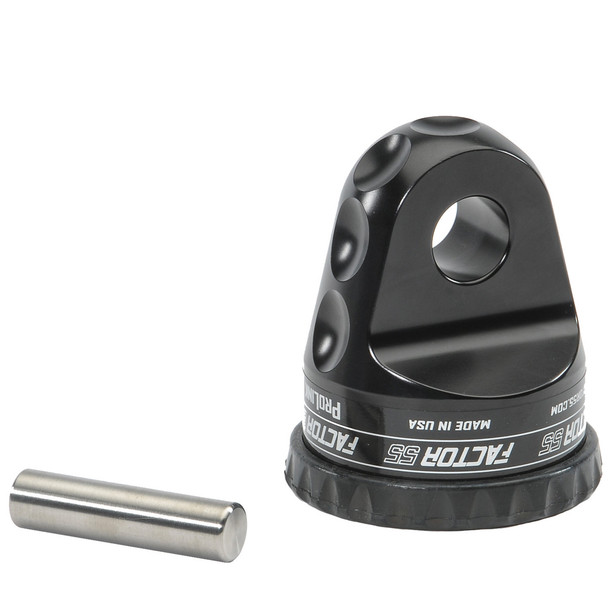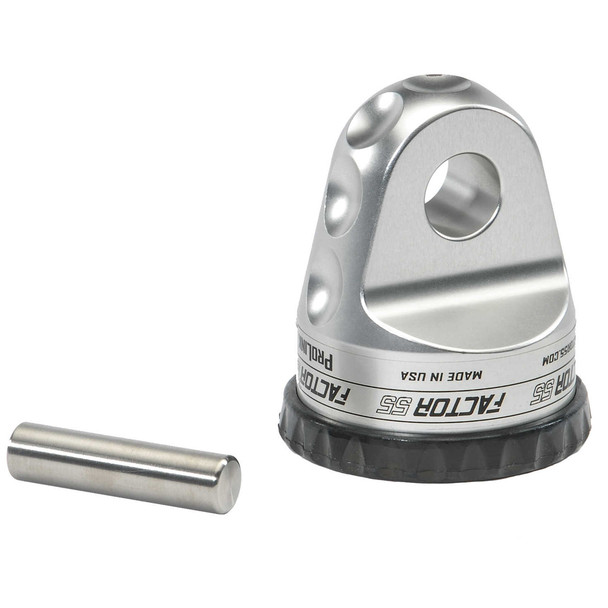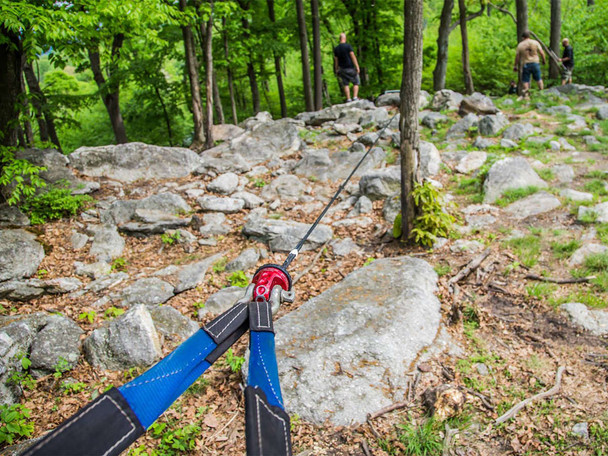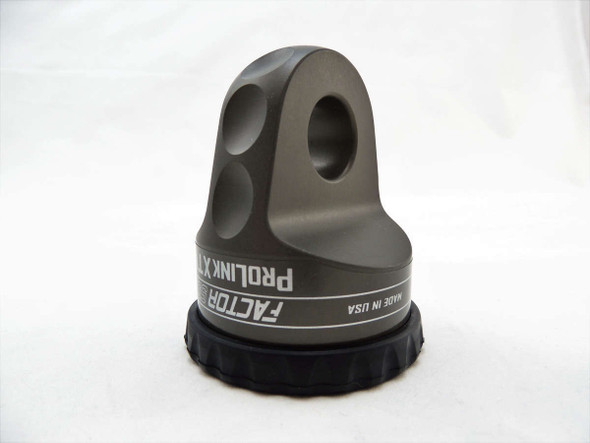Description
The Factor 55 ProLink shackle mount for steel cables and synthetic winch ropes replace conventional winch hooks with a safer, stronger, and smarter method of utilizing shackles while recovering vehicles.
Engineered and machined in the USA from lightweight billet 6061 aluminum, the Factor 55 ProLink provides a safe means to easily attach a standard 3/4" screw pin shackle to existing winch cable and rope eyes The cable or rope eye is captured into the body of the ProLink by a removable oversized 5/8" double shear pin.
The front of the ProLink provides the precision shackle mounting hole and massive 1.2" thick mounting tab. The ProLink is compatible with both Hawse and Roller fairleads and snugs neatly against both versions.
FAQ:
Hook or Screw Pin Shackle - which is better?
Smart off roaders have known for years that the most secure way to use your recovery winch is replace the hook with a common screw pin shackle. Unless you are competing, the added seconds required to use a shackle versus a hook during a vehicle recovery is not worth the safety risk associated with standard winch hooks.
What is wrong with the hook?
The technical name for a standard winch hook is " Clevis Slip Hook". This describes two things. First, clevis refers to the method of cable attachment - the cable eye is attached to the hook by a clevis pin and cotter pin. Second, "slip" refers to the size of the chain link that can be slipped through the hook opening. Most winches are equipped with 3/8 clevis slip hooks. This means that the hook is designed specifically to work with chains that have 3/8 thick chain links. Unless you are using chains in your recovery, this is not the right piece of hardware to have on the end of your winch cable. At Factor 55 we are still puzzled as to why winch manufacturers continue to sell winches equipped with hooks designed for chain links when off roaders have been using synthetic recovery straps for over two decades now.
In addition, most 3/8 clevis slip hooks have a safe working load limit of 4000-7000 pounds. The average 8K winch exceeds the working load limit of these weak hooks regularly. Of course the safety factor built into the hook is 3-4X, but it is still not wise to exceed any working load limit of any hardware. In contrary, the standard ¾ screw pin shackle has a working load limit (WLL) of 9500 pounds, and a safety factor of 5-6X. Most screw pin shackles have an ultimate breaking strength of 50,000 to 60,000 pounds.
The cross section of the standard hook is airfoil shaped to prevent chain links from slipping, and not ideal for synthetic strap fibers. This shape causes high fiber stresses that reduce the rating of the recovery strap. Hooks equipped with safety latches pose other hazards as well. Many safety latches are simply bent sheet metal parts with sharp edges and springs. This is not a concern with chains, but a potential cutting hazard for recovery straps. The safety latches cannot bear any loads as well.
The hook opening of the standard winch hook is too small to safely attach two ends of a common recovery strap so most off roaders use a screw pin shackle to hold the strap anyways.
Standard winch hooks do not stow neatly against either Hawse or roller fairleads. They were not designed to do this. That is why it is common to see winch cables extended and hooks attached to bumpers, tow hooks, undercarriage parts etc.. It is not recommended to leave the winch cable or synthetic rope pulling at a right angle to your fairlead simply to attach the hook to something convenient as this can permanently weaken the fibers right at the fairlead surface.
Anytime a hook is used, there is a chance that whatever you put into the hook opening can escape. This is especially important in vehicle recovery where the winch cable is cycling in a loaded and unloaded condition regularly as the towing vehicle or towed vehicle lurches forward. In contrary, the standard screw pin shackle is a completely contained link where strap ends have no way of escaping even during tight/loose cycles.
Is the ProLink compatible with steel and synthetic winch cables?
Yes!
Is the ProLink compatible with hawse and roller winch fairleads?
Yes!
Does anodizing fade/scratch?
Anodizing is the most durable way to ensure a long life for your ProLink's finish. However, like all off road parts, these are sure to take a beating. Black, silver, and gunmetal seem to hold up the longest in the sun. Red, blue, and orange, by nature of anodizing, will fade sooner than other colors.
FEATURES & BENEFITS:
- Screw pin shackles are up to 5X stronger than conventional winch hooks
- Conventional hooks are too small to safely fit both ends of a recovery strap
- Recovery straps cannot slip out of a shackle like they can with hooks Hook
- Safety latches are not rated for loads and can tear recovery straps
- Conventional hook surfaces add higher stresses to recovery strap fibers, resulting in decreased strap ratings
- Shackles can be quickly removed and stowed away until needed for winching
- Hooks do not cinch neatly against fairleads and are prone to rattling and loosening
- Conventional winch hooks are designed for chains not commonly used recovery straps
- Engineered, Tested, and Made in USA
- Patent Pending Stress analyzed using COSMOS FEA and destructively tested for confirmation
- Billet construction: precision machined from 6061-T6 Kaiser Aluminum round bar
- 16,000 pound max load rating
- Fits all steel cables and synthetic ropes up to 3/8" in diameter
- Fits eyes equipped with standard or tube thimbles to 3/8 inch diameters
- 1.2 inch shackle tab thickness virtually eliminates "shackle rattle"
- Massive 5/8 inch diameter carbon steel double shear pin (6Al-4V Titanium upgradeable)
- Optional EPDM "Rubber Guard" protects alloy Hawse fairleads
- Rubber barb attachment can be installed and removed in minutes
- Simple snap ring removal Cinches neatly against all types of fairleads
- Hawse or Roller Beautifully anodized and zinc plated in the USA





































